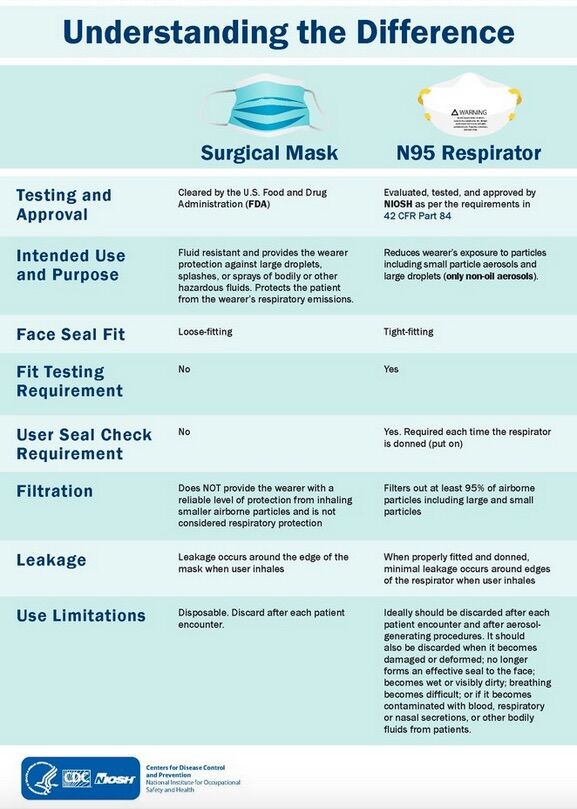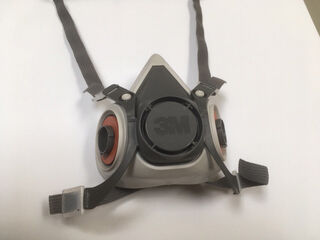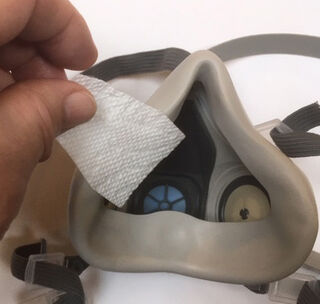Coronavirus Disease 2019
Effective Protection Against COVID Is Here
While masks provide 50% protection, respirators offer 99.97% filtration.
Posted June 27, 2020
On the SOAR fear of flying Zoom session last Wednesday, we discussed the risk of flying during this pandemic. Which airlines leave the middle seat open? What about a specialty airline that allows only a few passengers on each flight? What if a passenger refuses to wear a mask?
I haven't flown since the pandemic started. Even though I offer courses on fear of flying, my thinking has been that it is not wise to fly until the pandemic is over or a vaccine is available. This is because your mask doesn't protect you. It protects others. Even if every passenger wears a mask, the level of protection provided by masks is 50% at best, according to Dr. Christopher Murray, director of the Institute for Health Metrics and Evaluation at the University of Washington.
Though what health professionals wear looks like a mask, it isn't a mask. It is a disposable respirator. The difference between a mask and a respirator is important. Respirators fit tightly enough to provide a leak-free seal. Masks available to the public are not leak-free. Even if your mask has the filtering power of an N95 respirator, there is no filtering of the air that enters the mask through leaks. The public can't buy mask-style respirators that offer an air-tight fit.

Sure, if everyone used the masks that are available to us, in spite of the leak problem, the overall infection rate would be lower. But, to my thinking, 50% protection against a virus that is often fatal is not good enough to get me on a plane.
But, in the next few minutes, the picture changed. A person joined the Zoom session who had gotten advice from her physician on how to get really effective COVID-19 protection. Her physician advised her to purchase a respirator such as is used when spray-painting a car or removing asbestos. Here's what I found out when I looked into the advice she had been given.
Though N95 respirators are not available to the public, respirators for spray-painting cars, removing asbestos, etc. are available to the public and are not sold out. These respirators can be equipped with N95 or—even better—N100 filter cartridges.
There are a lot of respirators of this type on the market. They are available on Amazon, eBay, etc. After doing a few hours on the internet, I was sold on the respirator idea and purchased a 3M series 6000 respirator. There are three sizes. 3M says the medium size fits 80% of the adult population. They are usually sold without filters.

The photo here shows the respirator as it arrived with no filters attached. This respirator uses two filters, one on either side, fitted on the circular black opening surrounded by the red washer.
The 6000 series uses either a box filter or a disc-shaped filter. Filter ratings determined by the National Institute for Occupational Safety and Health (NIOSH). The letter, N, R, or P is not important, as N means not oil resistant, R means oil resistant, and P means oil-proof. The important thing is the number. The number 95 means the filter will remove 95% of 0.3 micron particles. The number 100 means the filter will remove 99.98% of 0.3 micron particles.
What is a micron? A micron is 1/1000th of a millimeter. What if the virus is smaller than that? As it turns out, the 0.3 micron size is used for testing because it is the most difficult particle size to filter. Particles smaller than 0.3 micron or larger than 0.3 micron are easier to filter out, which means the filter will block a high percentage of any other size particle. An N, R, or P 95 or 100 is considered adequate for COVID-19. If you want to dig into this, go to this link at USA Today.
There are videos on YouTube by 3M with details on how to use these respirators, which includes how to put them on, take them off, clean them, and check that they are properly sealed on your face. This video is for general purposes, and not specifically for COVID protection, So, don't miss the video by Dr. Yagnesh Desai on how to put the respirator on, take it off, and clean it with COVID in mind.
My next-door neighbor, a physician at Yale, assures me respirator protection works. He says there has not been a single case of COVID-19 transmission from a patient to any staff person. That being the case, it seems logical that a passenger can be adequately protected by using a properly fitted respirator and an eye covering, regardless of how crowded the cabin is.
After the flight, clothing and shoes worn on the flight needs to be removed and cleaned before reuse, Hands must be kept away from the face and must be cleaned with soap and water or disinfectant. Checked or carry-on items need to be disinfected as well.
You don't have to depend on others to protect you. You don't have to hope people aren't infected. You don't have to hope the middle seat is vacant. Even if the person on your left, on your right, those in the rows ahead and behind you all have COVID-19, are not wearing a mask and are coughing and sneezing, if you are wearing goggles and your respirator, have checked the seal, and remove your clothing after the flight and thoroughly wash up, you should be OK because this protection approximates that used in hospitals.

There is one more thing to consider. The air you breathe out goes out an outflow valve (the white round circular object near the paper being inserted in the photo). The air you breathe out is not filtered. Though this type of respirator protects you, it does not protect others. You can, however, protect others simply by placing a piece of filter material (paper towel, coffee filter, etc.) as shown inside the respirator over the outflow valve.
Don't just take these precautions when flying. My next-door neighbor, the Yale physician, puts on full protective gear even when he goes to the supermarket. He removes it when he gets home and washes up. Why be safe just when flying? Let's stay disciplined, as he does, on the ground as well. I know from working with anxious fliers that even with the best protection, anxiety is still an issue. For that, I'm proud to say my book on dealing with anxiety won the silver medal in a major book-of-the-year contest in the self-help category. It is supplemented by a book focused on COVID worries, anxieties, and claustrophobia. You can read a lengthy sample at this link.




